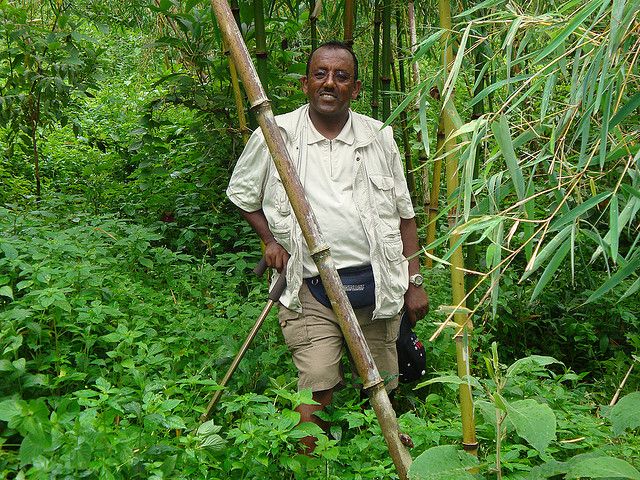Source: WRI
Written by: Kathleen Buckingham
Last month, 40 nations agreed to restore 5 million hectares (12.4 million acres) of degraded lands and areas of low-quality bamboo production into productive, healthy bamboo forests at the International Network for Bamboo and Rattan’s (INBAR) Ninth Council Session in Addis Ababa, Ethiopia. This pledge will help answer the Bonn Challenge—an effort to pledge to have 150 million hectares (370 million acres) of degraded and deforested lands in restoration programs by 2020—and could create significant environmental and climate benefits, if bamboo can overcome its image problem.
International alignment behind bamboo restoration is a huge step toward maximizing bamboo’s potential to tackle land degradation, carbon emissions and population growth challenges. Bamboo can make an immediate contribution to landscape restoration due to its ability to rapidly grow, bind soils, and maintain slope stability. Bamboo can also sustainably support local resource-based economies and has proven high carbon sequestration capacity to support climate change mitigation.
Some countries and organizations have already recognized bamboo as a secret weapon for forest restoration and land management. For example, the Chinese State Forest Administration has pledged to plant one million hectares and restore 3 million hectares (7.4 million acres), the Philippines will reforest at least 500,000 hectares (1.2 million acres), and India will have 100,000 hectares (247,000 acres) of degraded land under bamboo restoration programs by 2020. The Ethiopian government plans to increase bamboo coverage by 5 percent annually until 2015, with plans to restore nearly 500,000 hectares (1.2 million acres) of degraded land.
Africa Showcases Bamboo’s Potential and Challenges
Holding the INBAR session in Africa was no coincidence. Sub-Saharan Africa is home to approximately 3 million hectares (7.4 million acres) of bamboo forest, primarily Yushania alpina (a highland bamboo) and Oxytenanthera abyssinica(a lowland bamboo) growing on arid or very poor soils), and the experiences of two African nations highlight the potential and challenges facing bamboo restoration.
Consider Ethiopia, home to the largest area of natural bamboo in Africa: about 67 percent of all African bamboos and 7 percent of all global bamboo resources are found in the country. Ethiopia has committed to restore a sixth of its land into productivity by 2025, with bamboo playing a key role in the effort. President Mulatu Teshome opened the INBAR and Ethiopian Ministry of Agriculture’s Bamboo and Rattan in the Green Economy Policy Dialogue, which convened African decision-makers, development experts, and the private sector. Ethiopia’s Minister of Agriculture touted bamboo’s potential, saying, “Here and in many countries, bamboo has a place at the center of integrated watershed strategies and land management schemes.”
In comparison, Ghana has 400,000 hectares (988,000 acres) of bamboo, including eight native and 14 introduced species, but little progress is being made on restoration. Gold mining has resulted in severe forest and land degradation, and bamboo can rehabilitate land in denuded landscapes scarred by mining activities. While successful small-scale bamboo restoration pilot projects have been conducted by mining companies with legal agreements to restore the land, the scale of degradation caused by illegal mining and the need for large-scale trials utilizing bamboo as a pioneer species to reclaim degraded areas is not being addressed. Ghana aims to pilot 1,000 hectares (2,471 acres) of bamboo restoration in two regions, but still lacks funding and investment for the projects, even with a national goal to restore 20,000 hectares (49,000 acres) of land annually for the next 20 years.
Overall, bamboo restoration’s main challenge may be its brand, a debate on full display at INBAR’s session. The European Union’s ambassador to the African Union, H.E. Gary Quince, put it bluntly: “Bamboo has an image problem.” Meanwhile, the deputy director general of China’s State Forestry Administration, Wang Chengfeng, underlined the need to integrate bamboo into national definitions of forests by urging the Intergovernmental Panel on Climate Change (IPCC) to develop a methodology for carbon stored in bamboo and to include bamboo in national greenhouse gas inventories.
World Bank representative Million Alemayehu Gizaw and United Nations Environment Programme representative Desta Mebratu both welcomed research and development into potential impacts of bamboo to ensure it supports the ecosystems it intends to restore. GIZ representative Melaku Tadesse noted commercializing bamboo products still faces research, product innovation, information, technology transfer, and marketing hurdles, despite its promising market potential. Fortunately, WRI and INBAR are already building a partnership to explore how bamboo can be used for restoration.
Getting Beyond Bamboo’s Image
While it may be seen as a weed or perceived mostly as an invasive species (although there are native bamboo species on almost every continent), the perception of bamboo needs to be updated, and brought into mainstream forestry institutions. While no silver bullet exists for the restoration challenge, bamboo plays an important role in building a sustainable future, whether it be carbon sequestration, erosion control or livelihood development.
If bamboo’s biggest hurdle is its image, we can overcome it. But to address concerns and fully understand the potential of bamboo as a resource, we need data from successful restoration projects to educate policymakers and drive investment in research and development. Only then can bamboo realize its potential as a scalable solution to some of our biggest challenges in a warming world.
Read the original blog post here


